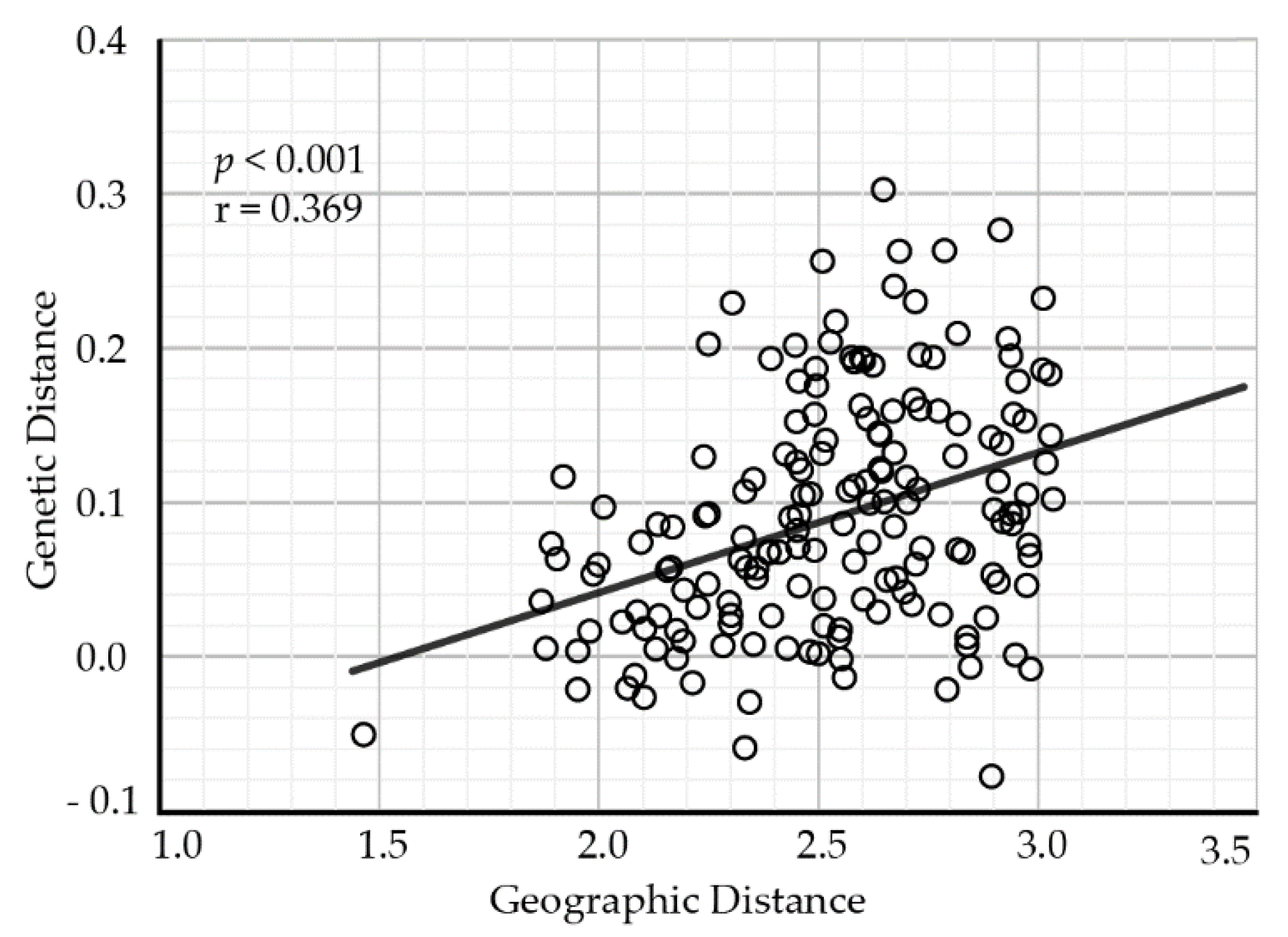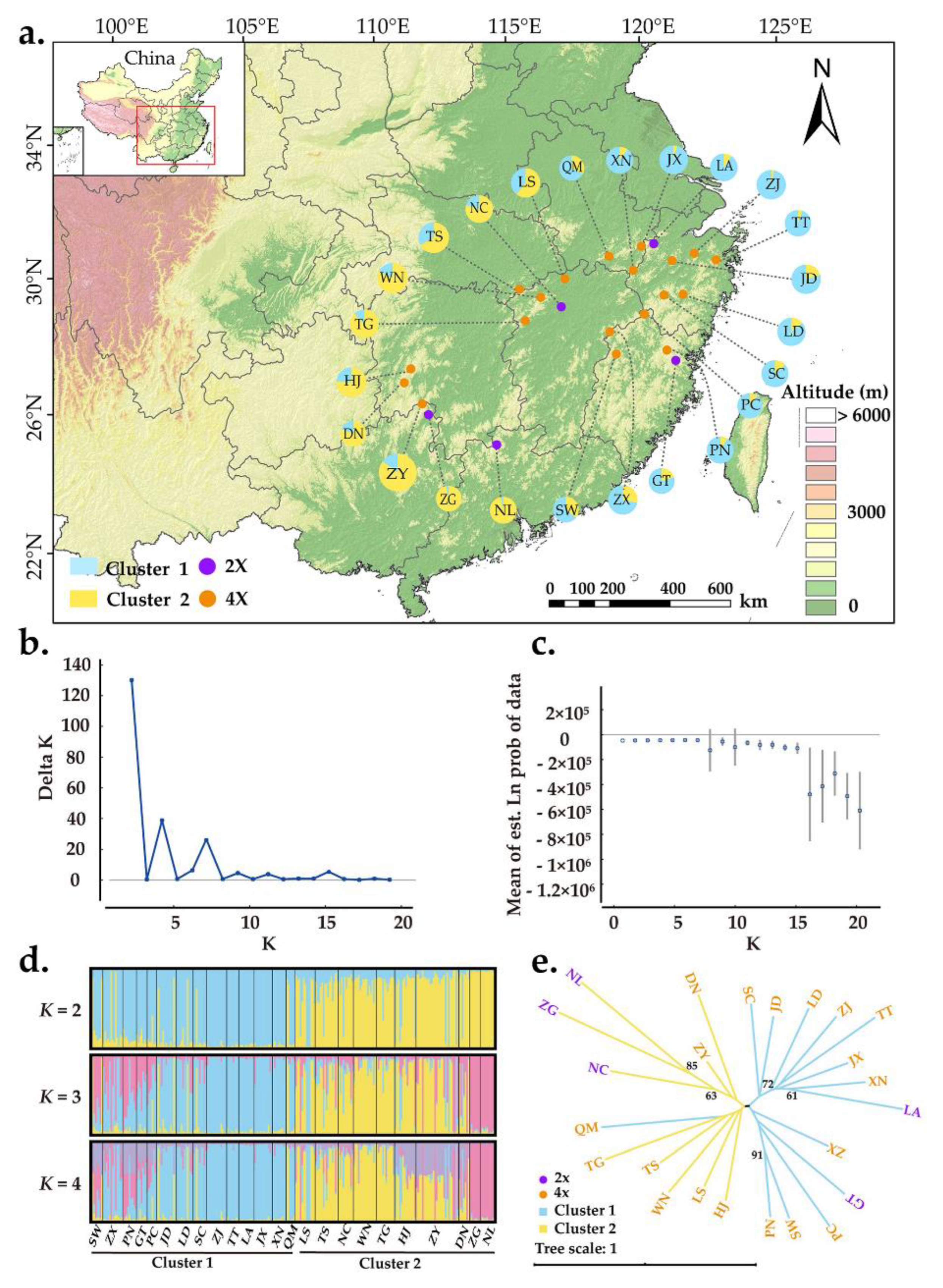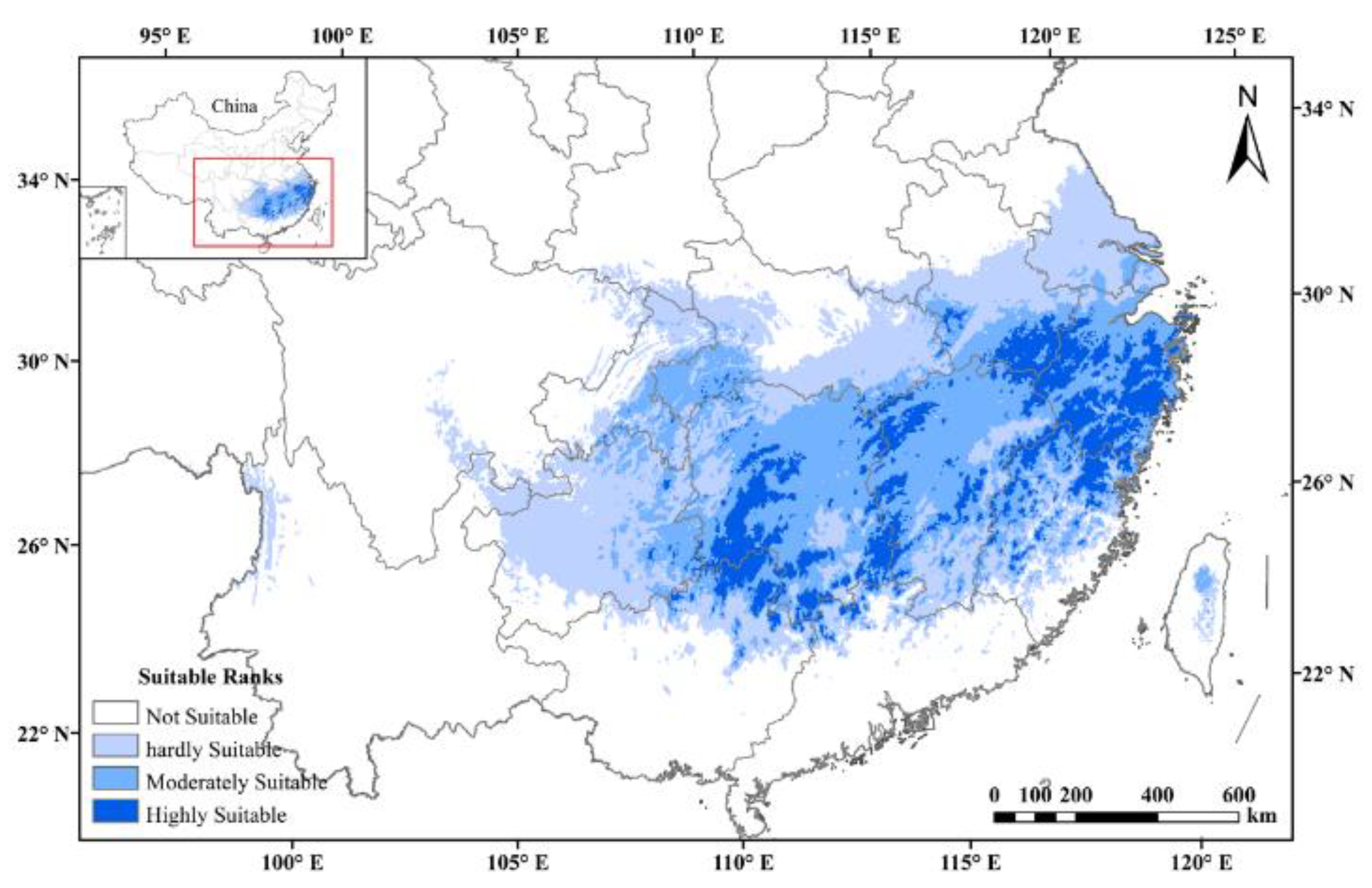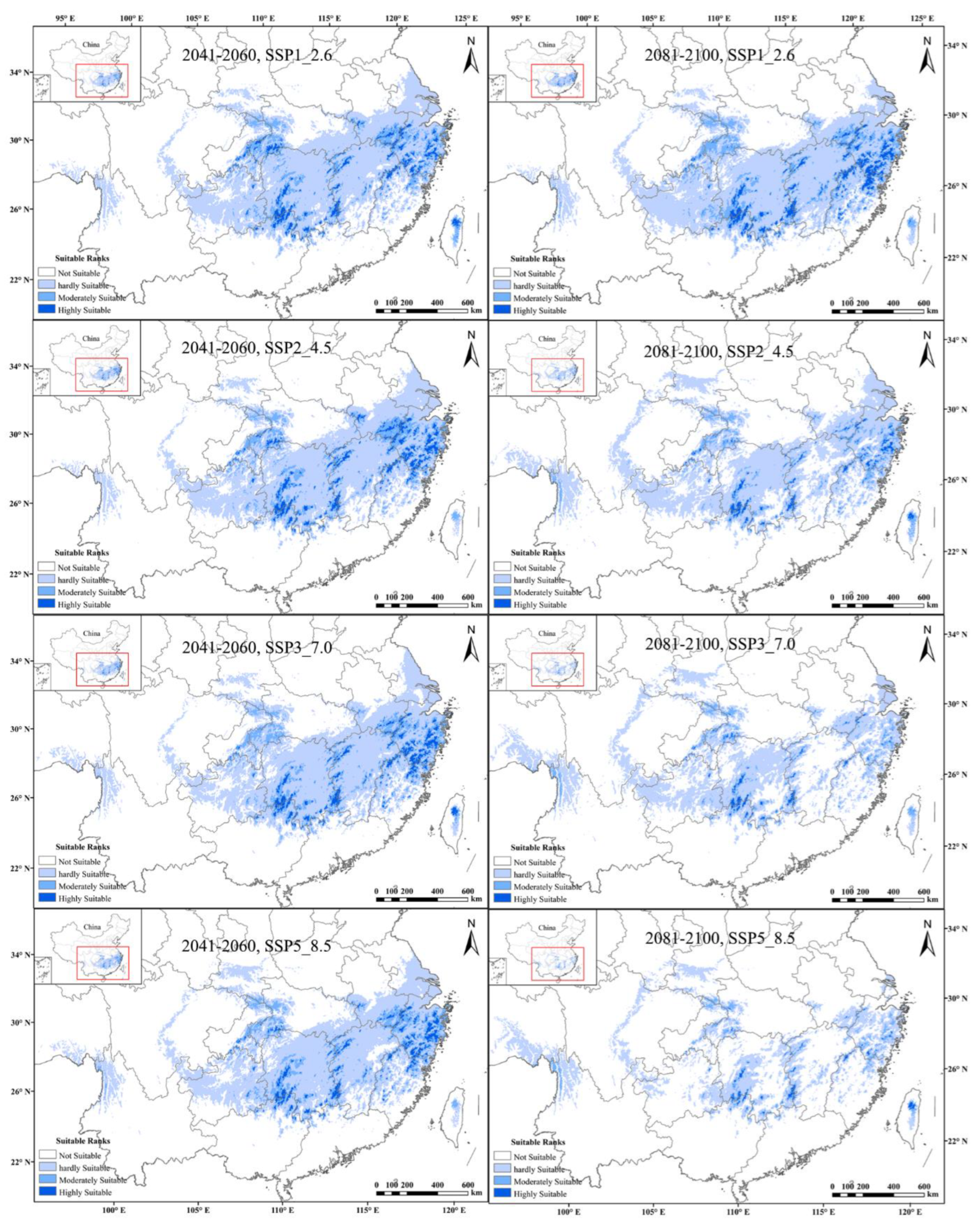Characterizing Tetraploid Populations of Actinidia chinensis for Kiwifruit Genetic Improvement
Abstract
:1. Introduction
2. Results
2.1. Genetic Diversity of A. chinensis Populations
2.2. Genetic Structure and Differentiation of A. chinensis
2.3. Environmental Niche of Tetraploid A. chinensis
3. Discussion
3.1. Genetic Diversity of Diploids and Tetraploids
3.2. Population Genetic Structure and Differentiation
3.3. Occurrence of Tetraploids in A. chinensis
3.4. Implications for Conservation and Utilization
4. Materials and Methods
4.1. Sample Collection
4.2. DNA Extraction and Microsatellite Genotyping
4.3. SSR Data Analysis
4.4. Species Distribution Models (SDMs)
5. Conclusions
Supplementary Materials
Author Contributions
Funding
Institutional Review Board Statement
Informed Consent Statement
Data Availability Statement
Acknowledgments
Conflicts of Interest
References
- Testolin, R.; Huang, H.W.; Ferguson, A.R. (Eds.) The Kiwifruit Genome; Springer: Cham, Switzerland, 2016. [Google Scholar]
- Richardson, D.P.; Ansell, J.; Drummond, L.N. The nutritional and health attributes of kiwifruit: A review. Eur. J. Nutr. 2018, 57, 2659–2676. [Google Scholar] [CrossRef] [Green Version]
- Wang, S.; Qiu, Y.; Zhu, F. Kiwifruit (Actinidia spp.): A review of chemical diversity and biological activities. Food Chem. 2021, 350, 128469. [Google Scholar] [CrossRef] [PubMed]
- Sanz, V.; López-Hortas, L.; Torres, M.D.; Domínguez, H. Trends in kiwifruit and byproducts valorization. Trends Food Sci. Technol. 2021, 107, 401–414. [Google Scholar] [CrossRef]
- Huang, H.; Liu, Y. Natural hybridization, introgression breeding, and cultivar improvement in the genus Actinidia. Tree Genet. Genomes 2014, 10, 1113–1122. [Google Scholar] [CrossRef]
- Liu, Y.; Li, D.; Zhang, Q.; Song, C.; Zhong, C.; Zhang, X.; Wang, Y.; Yao, X.; Wang, Z.; Zeng, S.; et al. Rapid radiations of both kiwifruit hybrid lineages and their parents shed light on a two-layer mode of species diversification. New Phytol. 2017, 215, 877–890. [Google Scholar] [CrossRef] [PubMed] [Green Version]
- Huang, H.; Ferguson, A.R. Kiwifruit in China. N. Z. J. Crop. Hort. 2001, 29, 1–14. [Google Scholar] [CrossRef]
- Yu, W.; Wu, B.; Wang, X.; Yao, Z.; Li, Y.; Liu, Y. Scale-dependent effects of habitat fragmentation on the genetic diversity of Actinidia chinensis populations in China. Hortic. Res. 2020, 7, 172. [Google Scholar] [CrossRef]
- Li, D.; Liu, Y.; Li, X.; Rao, J.; Yao, X.; Zhong, C. Genetic diversity in kiwifruit polyploid complexes: Insights into cultivar evaluation, conservation, and utilization. Tree Genet. Genomes 2014, 10, 1451–1463. [Google Scholar] [CrossRef]
- Zhou, J.; Liu, Y.; Huang, H. Characterization of 15 novel single nucleotide polymorphisms (SNPs) in the Actinidia chinensis species complex (Actinidiaceae). Am. J. Bot. 2011, 98, e100–e102. [Google Scholar] [CrossRef]
- Bogačiovienė, S.; Česonienė, L.; Ercisli, S.; Valatavičius, A.; Jakštys, B.; Šatkauskas, S.; Paulauskas, A. Ploidy levels and genetic diversity of Actinidia arguta (Sieboldand Zucc.) Planch. ex Miq.; A. kolomikta (Rupr.and Maxim.) Maxim.; A. callosa Lindl.; and A. melanandra Franch.; accessions. Genet. Resour. Crop. Ev. 2019, 66, 1107–1118. [Google Scholar] [CrossRef]
- Tahir, J.; Brendolise, C.; Hoyte, S.; Lucas, M.; Thomson, S.; Hoeata, K.; McKenzie, C.; Wotton, A.; Funnell, K.; Morgan, E.; et al. Qtl mapping for resistance to cankers induced by Pseudomonas Syringae pv. Actinidiae (psa) in a tetraploid Actinidia chinensis kiwifruit population. Pathogens 2020, 9, 967. [Google Scholar] [CrossRef] [PubMed]
- Li, S.; Liu, X.; Liu, H.; Zhang, X.; Ye, Q.; Zhang, H. Induction, identification and genetics analysis of tetraploid Actinidia chinensis. R. Soc. Open Sci. 2019, 6, 191052. [Google Scholar] [CrossRef] [PubMed] [Green Version]
- Wang, Y.C.; Liao, L.; Li, Z.Z. Genetic differentiation of Actinidia chinensis and analysis of gene flow barriers in the Qinling Mountains, the species’ northern distribution boundary. Genet. Resour. Crop. Ev. 2018, 65, 881–895. [Google Scholar] [CrossRef]
- Van Inghelandt, D.; Melchinger, A.E.; Lebreton, C.; Stich, B. Population structure and genetic diversity in a commercial maize breeding program assessed with SSR and SNP markers. Theor. Appl. Genet. 2010, 120, 1289–1299. [Google Scholar] [CrossRef] [Green Version]
- Birch, E.L. A Review of “Climate Change 2014: Impacts, Adaptation, and Vulnerability” and “Climate Change 2014: Mitigation of Climate Change”. J. Am. Plan. Assoc. 2014, 80, 184–185. [Google Scholar] [CrossRef]
- Li, G.; Du, S.; Wen, Z. Mapping the climatic suitable habitat of oriental arborvitae (Platycladus orientalis) for introduction and cultivation at a global scale. Sci. Rep. 2016, 6, 30009. [Google Scholar] [CrossRef] [Green Version]
- Zhang, K.; Yao, L.; Meng, J.; Tao, J. Maxent modeling for predicting the potential geographical distribution of two peony species under climate change. Sci. Total Environ. 2018, 634, 1326–1334. [Google Scholar] [CrossRef]
- Wei, B.; Wang, R.; Hou, K.; Wang, X.; Wu, W. Predicting the current and future cultivation regions of Carthamus tinctorius L. using MaxEnt model under climate change in China. Glob. Ecol. Conserv. 2018, 16, e00477. [Google Scholar] [CrossRef]
- Knox, J.S.; Bezold, K.; Cabe, P.R.; Williams, S.; Simurda, M.C. Genetic diversity and population structure of the endemic disjunct species, Helenium virginicum (Asteraceae). Am. Midl. Nat. 2016, 175, 242–260. [Google Scholar] [CrossRef]
- Diniz-Filho, J.A.F.; Soares, T.N.; Lima, J.S.; Dobrovolski, R.; Landeiro, V.L.; Telles, M.P.D.C.; Rangel, T.F.; Bini, L.M. Mantel test in population genetics. Genet. Mol. Biol. 2013, 36, 475–485. [Google Scholar] [CrossRef] [Green Version]
- Wang, Z.; Zhong, C.; Li, D.; Yan, C.; Yao, X.; Li, Z. Cytotype distribution and chloroplast phylogeography of the Actinidia chinensis complex. BMC Plant Biol. 2021, 21, 325. [Google Scholar] [CrossRef] [PubMed]
- Grant, V. Plant Speciation; Columbia University Press: New York, NY, USA, 1981. [Google Scholar]
- Soltis, P.S.; Marchant, D.B.; Van de Peer, Y.; Soltis, D.E. Polyploidy and genome evolution in plants. Curr. Opin. Genet. Dev. 2015, 35, 119–125. [Google Scholar] [CrossRef] [Green Version]
- Han, T.S.; Zheng, Q.J.; Onstein, R.E.; Rojas-Andrés, B.M.; Hauenschild, F.; Muellner-Riehl, A.N.; Xing, Y.W. Polyploidy promotes species diversification of Allium through ecological shifts. New Phytol. 2020, 225, 571–583. [Google Scholar] [CrossRef] [PubMed] [Green Version]
- Schlaepfer, D.R.; Edwards, P.J.; Billeter, R. Why only tetraploid Solidago gigantea (Asteraceae) became invasive: A common garden comparison of ploidy levels. Oecologia 2010, 163, 661–673. [Google Scholar] [CrossRef] [PubMed] [Green Version]
- Wei, N.; Cronn, R.; Liston, A.; Ashman, T.L. Functional trait divergence and trait plasticity confer polyploid advantage in heterogeneous environments. New Phytol. 2019, 221, 2286–2297. [Google Scholar] [CrossRef] [Green Version]
- Ramsey, J.; Ramsey, T.S. Ecological studies of polyploidy in the 100 years following its discovery. Philos. Trans. R. Soc. Lond. B Biol. Sci. 2014, 369, 20130352. [Google Scholar] [CrossRef] [PubMed]
- Li, J.; Wan, Q.; Guo, Y.P.; Abbott, R.J.; Rao, G.Y. Should I stay or should I go: Biogeographic and evolutionary history of a polyploid complex (Chrysanthemum indicum complex) in response to Pleistocene climate change in China. New Phytol. 2014, 201, 1031–1044. [Google Scholar] [CrossRef]
- López-Jurado, J.; Mateos-Naranjo, E.; Balao, F. Niche divergence and limits to expansion in the high polyploid Dianthus broteri complex. New Phytol. 2019, 222, 1076–1087. [Google Scholar] [CrossRef]
- Liu, Y.; Li, D.; Yan, L.; Huang, H. The microgeographical patterns of morphological and molecular variation of a mixed ploidy population in the species complex Actinidia chinensis. PLoS ONE 2015, 10, e0117596. [Google Scholar] [CrossRef]
- Crowhurst, R.N.; Gleave, A.P.; MacRae, E.A.; Ampomah-Dwamena, C.; Atkinson, R.G.; Beuning, L.L.; Bulley, S.M.; Chagne, D.; Marsh, K.B.; Matich, A.J.; et al. Analysis of expressed sequence tags from Actinidia: Applications of a cross species EST database for gene discovery in the areas of flavor, health, color, and ripening. BMC Genom. 2008, 9, 351. [Google Scholar] [CrossRef] [Green Version]
- Zheng, Y.Q.; Li, Z.Z.; Huang, H.W. Preliminary study on SSR analysis in kiwifruit cultivars. J. Wuhan Bot. Res. 2003, 21, 444–448. [Google Scholar]
- Servick, S.; Visger, C.J.; Gitzendanner, M.A.; Soltis, P.S.; Soltis, D.E. Population genetic variation, geographic structure, and multiple origins of autopolyploidy in Galax urceolata. Am. J. Bot. 2015, 102, 973–982. [Google Scholar] [CrossRef] [PubMed] [Green Version]
- Zhang, X.; Su, H.; Yang, J.; Feng, L.; Li, Z.; Zhao, G. Population genetic structure, migration, and polyploidy origin of a medicinal species Gynostemma pentaphyllum (Cucurbitaceae). Ecol. Evol. 2019, 9, 11145–11170. [Google Scholar] [CrossRef] [PubMed] [Green Version]
- Zhong, L.; Ma, Y.; Salama, M.; Su, Z. Assessment of vegetation dynamics and their response to variations in precipitation and temperature in the Tibetan Plateau. Clim. Chang. 2010, 103, 519–535. [Google Scholar] [CrossRef]
- Li, D.; Liu, Y.; Zhong, C.; Huang, H. Morphological and cytotype variation of wild kiwifruit (Actinidia chinensis complex) along an altitudinal and longitudinal gradient in central-west China. Bot. J. Linn. Soc. 2010, 164, 72–83. [Google Scholar] [CrossRef] [Green Version]
- Rogers, S.O.; Bendich, A.J. Extraction of DNA from milligram amount of fresh, herbarium and mummified plant tissues. Plant Mol. Biol. 1985, 5, 69–76. [Google Scholar] [CrossRef]
- Huang, W.G.; Cipriani, G.; Morgante, M.; Testolin, R. Microsatellite DNA in Actinidia chinensis: Isolation, characterization, and homology in related species. Theor. Appl. Genet. 1998, 97, 1269–1278. [Google Scholar] [CrossRef]
- Sampson, J.F.; Byrne, M. Genetic diversity and multiple origins of polyploid Atriplex nummularia Lindl. (Chenopodiaceae). Biol. J. Linn. Soc. 2012, 105, 218–230. [Google Scholar] [CrossRef] [Green Version]
- Obbard, D.J.; Harris, S.A.; Pannell, J.R. Simple allelic-phenotype diversity and differentiation statistics for allopolyploids. Heredity 2006, 97, 296–303. [Google Scholar] [CrossRef] [PubMed] [Green Version]
- García-Verdugo, C.; Calleja, J.A.; Vargas, P.; Silva, L.; Moreira, O.; Pulido, F. Polyploidy and microsatellite variation in the relict tree Prunus lusitanica L.: How effective are refugia in preserving genotypic diversity of clonal taxa? Mol. Ecol. 2013, 22, 1546–1557. [Google Scholar] [CrossRef]
- Esselink, G.D.; Nybom, H.; Vosman, B. Assignment of allelic configuration in polyploids using the MAC-PR (microsatellite DNA allele counting-peak ratios) method. Theor. Appl. Genet. 2004, 109, 402–408. [Google Scholar] [CrossRef] [PubMed]
- Meirmans, P.G. GENODIVE version 3.0: Easy-to-use software for the analysis of genetic data of diploids and polyploids. Mol. Ecol. Resour. 2020, 20, 1126–1131. [Google Scholar] [CrossRef] [PubMed] [Green Version]
- Dufresne, F.; Stift, M.; Vergilino, R.; Mable, B.K. Recent progress and challenges in population genetics of polyploid organisms: An overview of current state-of-the-art molecular and statistical tools. Mol. Ecol. 2014, 23, 40–69. [Google Scholar] [CrossRef] [PubMed] [Green Version]
- Meirmans, P.G.; Liu, S.; van Tienderen, P.H. The analysis of polyploid genetic data. J. Hered. 2018, 109, 283–296. [Google Scholar] [CrossRef]
- Clark, L.V.; Jasieniuk, M. POLYSAT: An R package for polyploid microsatellite analysis. Mol. Ecol. Resour. 2011, 11, 562–566. [Google Scholar] [CrossRef]
- Huang, K.; Dunn, D.W.; Ritland, K.; Li, B.G. POLYGENE: Population genetics analyses for autopolyploids based on allelic phenotypes. Methods Ecol. Evol. 2020, 11, 448–456. [Google Scholar] [CrossRef] [Green Version]
- Nei, M. Analysis of gene diversity in subdivided populations. Proc. Natl. Acad. Sci. USA 1973, 70, 3321–3323. [Google Scholar] [CrossRef] [Green Version]
- Excoffier, L.; Smouse, P.E.; Quattro, J.M. Analysis of molecular variance inferred from metric distances among DNA haplotypes: Application to human mitochondrial DNA restriction data. Genetics 1992, 131, 479–491. [Google Scholar] [CrossRef]
- Rousset, F. Genetic differentiation and estimation of gene flow from F-statistics under isolation by distance. Genetics 1997, 145, 1219–1228. [Google Scholar] [CrossRef] [PubMed]
- Cavalli-Sforza, L.L.; Edwards, A.W.F. Phylogenetic analysis: Models and estimation. Evolution 1967, 21, 550–570. [Google Scholar] [CrossRef]
- Pritchard, J.K.; Stephens, M.; Donnelly, P. Inference of population structure using multilocus genotype data. Genetics 2000, 155, 945–959. [Google Scholar] [CrossRef] [PubMed]
- Falush, D.; Stephens, M.; Pritchard, J.K. Inference of population structure using multilocus genotype data: Linked loci and correlated allele frequencies. Genetics 2003, 164, 1567–1587. [Google Scholar] [CrossRef] [PubMed]
- Earl, D.A.; Vonholdt, B.M. STRUCTURE HARVESTER: A website and program for visualizing STRUCTURE output and implementing the Evanno method. Conserv. Genet. Resour. 2012, 4, 359–361. [Google Scholar] [CrossRef]
- Evanno, G.; Regnaut, S.; Goudet, J. Detecting the number of clusters of individuals using the software STRUCTURE: A simulation study. Mol. Ecol. 2005, 14, 2611–2620. [Google Scholar] [CrossRef] [Green Version]
- Jakobsson, M.; Rosenberg, N.A. CLUMPP: A cluster matching and permutation program for dealing with label switching and multimodality in analysis of population structure. Bioinformatics 2007, 23, 1801–1806. [Google Scholar] [CrossRef] [PubMed] [Green Version]
- Rosenberg, N.A. DISTRUCT: A program for the graphical display of population structure. Mol. Ecol. Notes 2004, 4, 137–138. [Google Scholar] [CrossRef]
- Takezaki, N.; Nei, M.; Tamura, K. Poptree 2: Software for constructing population trees from allele frequency data and computing other population statistics with Windows interface. Mol. Biol. Evol. 2010, 27, 747–752. [Google Scholar] [CrossRef] [Green Version]
- Phillips, S.J.; Anderson, R.P.; Schapire, R.E. Maximum entropy modeling of species geographic distributions. Ecol. Model. 2006, 190, 231–259. [Google Scholar] [CrossRef] [Green Version]
- Phillips, S.J.; Dudík, M. Modeling of species distributions with Maxent: New extensions and a comprehensive evaluation. Ecography 2008, 31, 161–175. [Google Scholar] [CrossRef]
- Fick, S.E.; Hijmans, R.J. WorldClim 2: New 1-km spatial resolution climate surfaces for global land areas. Int. J. Climatol. 2017, 37, 4302–4315. [Google Scholar] [CrossRef]
- Van Vuuren, D.P.; Riahi, K. A proposal for a new scenario framework to support research and assessment in different climate research communities. Glob. Environ. Chang. 2012, 22, 21–35. [Google Scholar] [CrossRef] [Green Version]
- Fawcett, T. An introduction to ROC analysis. Pattern Recogn. Lett. 2006, 27, 861–874. [Google Scholar] [CrossRef]





| Population | GENODIVE | POLYGENE | |||||||
|---|---|---|---|---|---|---|---|---|---|
| Na | Ne | Ho | He | Fis | Ho | He | PIC | I | |
| GT | 5.050 | 3.709 | 0.552 | 0.756 | 0.269 | 0.738 | 0.684 | 0.648 | 1.432 |
| NL | 4.625 | 3.109 | 0.537 | 0.670 | 0.198 | 0.681 | 0.636 | 0.598 | 1.294 |
| ZG | 4.250 | 3.037 | 0.598 | 0.672 | 0.109 | 0.721 | 0.636 | 0.593 | 1.25 |
| NC | 6.400 | 4.519 | 0.648 | 0.787 | 0.178 | 0.803 | 0.746 | 0.714 | 1.64 |
| LA | 7.525 | 5.289 | 0.737 | 0.802 | 0.080 | 0.808 | 0.761 | 0.736 | 1.749 |
| JX | 10.250 | 5.842 | 0.625 | 0.805 | 0.224 | 0.779 | 0.775 | 0.756 | 1.925 |
| QM | 7.750 | 4.901 | 0.616 | 0.829 | 0.256 | 0.77 | 0.763 | 0.743 | 1.796 |
| XN | 9.675 | 5.602 | 0.627 | 0.803 | 0.219 | 0.779 | 0.772 | 0.752 | 1.902 |
| PC | 7.000 | 4.384 | 0.528 | 0.811 | 0.349 | 0.738 | 0.735 | 0.709 | 1.675 |
| PN | 6.675 | 3.863 | 0.566 | 0.698 | 0.189 | 0.69 | 0.682 | 0.649 | 1.515 |
| SW | 7.575 | 4.295 | 0.571 | 0.770 | 0.258 | 0.733 | 0.721 | 0.698 | 1.675 |
| ZY | 12.775 | 6.437 | 0.534 | 0.800 | 0.333 | 0.755 | 0.748 | 0.73 | 1.908 |
| TS | 12.025 | 6.296 | 0.594 | 0.817 | 0.272 | 0.78 | 0.776 | 0.759 | 1.99 |
| DN | 8.100 | 5.252 | 0.522 | 0.855 | 0.389 | 0.75 | 0.737 | 0.713 | 1.738 |
| HJ | 11.025 | 6.118 | 0.584 | 0.809 | 0.278 | 0.775 | 0.773 | 0.754 | 1.946 |
| LS | 10.825 | 6.092 | 0.604 | 0.809 | 0.253 | 0.79 | 0.786 | 0.766 | 1.968 |
| TG | 9.975 | 5.446 | 0.625 | 0.804 | 0.223 | 0.785 | 0.776 | 0.757 | 1.908 |
| WN | 10.425 | 5.772 | 0.641 | 0.799 | 0.197 | 0.79 | 0.788 | 0.768 | 1.947 |
| ZX | 9.475 | 5.035 | 0.552 | 0.782 | 0.294 | 0.749 | 0.741 | 0.719 | 1.785 |
| JD | 11.375 | 6.354 | 0.621 | 0.822 | 0.244 | 0.8 | 0.795 | 0.777 | 2.015 |
| LD | 9.850 | 5.774 | 0.563 | 0.816 | 0.310 | 0.77 | 0.763 | 0.741 | 1.864 |
| SC | 9.150 | 5.187 | 0.611 | 0.801 | 0.237 | 0.778 | 0.778 | 0.755 | 1.873 |
| TT | 8.800 | 5.225 | 0.610 | 0.804 | 0.241 | 0.771 | 0.77 | 0.747 | 1.85 |
| ZJ | 9.700 | 5.434 | 0.650 | 0.805 | 0.193 | 0.791 | 0.78 | 0.759 | 1.89 |
| Average (2x) | 5.570 | 3.933 | 0.614 | 0.737 | 0.167 | 0.75 | 0.693 | 0.658 | 1.473 |
| Average (4x) | 9.601 | 5.437 | 0.592 | 0.802 | 0.265 | 0.767 | 0.761 | 0.736 | 1.851 |
| Average (all) | 8.761 | 5.124 | 0.597 | 0.789 | 0.241 | 0.764 | 0.746 | 0.723 | 1.772 |
| Source of Variation | DF | SS | MS | Variance Component | Percentage of Variation (%) | Fixation Index |
|---|---|---|---|---|---|---|
| Among populations | 23 | 2829.428 | 123.019 | 5.865 | 9.01% | FST = 0.090 * |
| Within populations | 239 | 14,154.572 | 59.224 | 59.224 | 90.99% | |
| Among clusters | 1 | 279.915 | 279.915 | 1.642 | 2.50% | FST = 0.025 * |
| Within clusters | 261 | 16,704.085 | 64.000 | 64.000 | 97.50% | |
| Among ploidy types | 1 | 215.479 | 215.479 | 2.102 | 3.17% | FST = 0.032 * |
| Within ploidy types | 261 | 16,768.521 | 64.247 | 64.247 | 96.83% |
Publisher’s Note: MDPI stays neutral with regard to jurisdictional claims in published maps and institutional affiliations. |
© 2022 by the authors. Licensee MDPI, Basel, Switzerland. This article is an open access article distributed under the terms and conditions of the Creative Commons Attribution (CC BY) license (https://creativecommons.org/licenses/by/4.0/).
Share and Cite
Wang, Z.; Hu, G.; Li, Z.; Zhong, C.; Yao, X. Characterizing Tetraploid Populations of Actinidia chinensis for Kiwifruit Genetic Improvement. Plants 2022, 11, 1154. https://doi.org/10.3390/plants11091154
Wang Z, Hu G, Li Z, Zhong C, Yao X. Characterizing Tetraploid Populations of Actinidia chinensis for Kiwifruit Genetic Improvement. Plants. 2022; 11(9):1154. https://doi.org/10.3390/plants11091154
Chicago/Turabian StyleWang, Zhi, Guangming Hu, Zuozhou Li, Caihong Zhong, and Xiaohong Yao. 2022. "Characterizing Tetraploid Populations of Actinidia chinensis for Kiwifruit Genetic Improvement" Plants 11, no. 9: 1154. https://doi.org/10.3390/plants11091154
APA StyleWang, Z., Hu, G., Li, Z., Zhong, C., & Yao, X. (2022). Characterizing Tetraploid Populations of Actinidia chinensis for Kiwifruit Genetic Improvement. Plants, 11(9), 1154. https://doi.org/10.3390/plants11091154







